 Search by Keyword
|
“Introducing…THE BEATLES”
(VJLP-1062)
Released January 10th, 1964
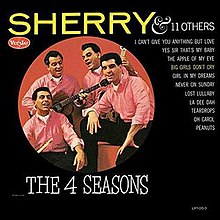 Vee-Jay Records had the historic privilege of being the label to release the very first Beatles album in the United States. This Chicago based record label boasted its major successes with R&B, blues and soul records. By 1962, they had grown in stature enough to also sign popular music artists, including The Four Seasons, with many placements in the Billboard Hot 100 to its credit. Vee-Jay Records had the historic privilege of being the label to release the very first Beatles album in the United States. This Chicago based record label boasted its major successes with R&B, blues and soul records. By 1962, they had grown in stature enough to also sign popular music artists, including The Four Seasons, with many placements in the Billboard Hot 100 to its credit.
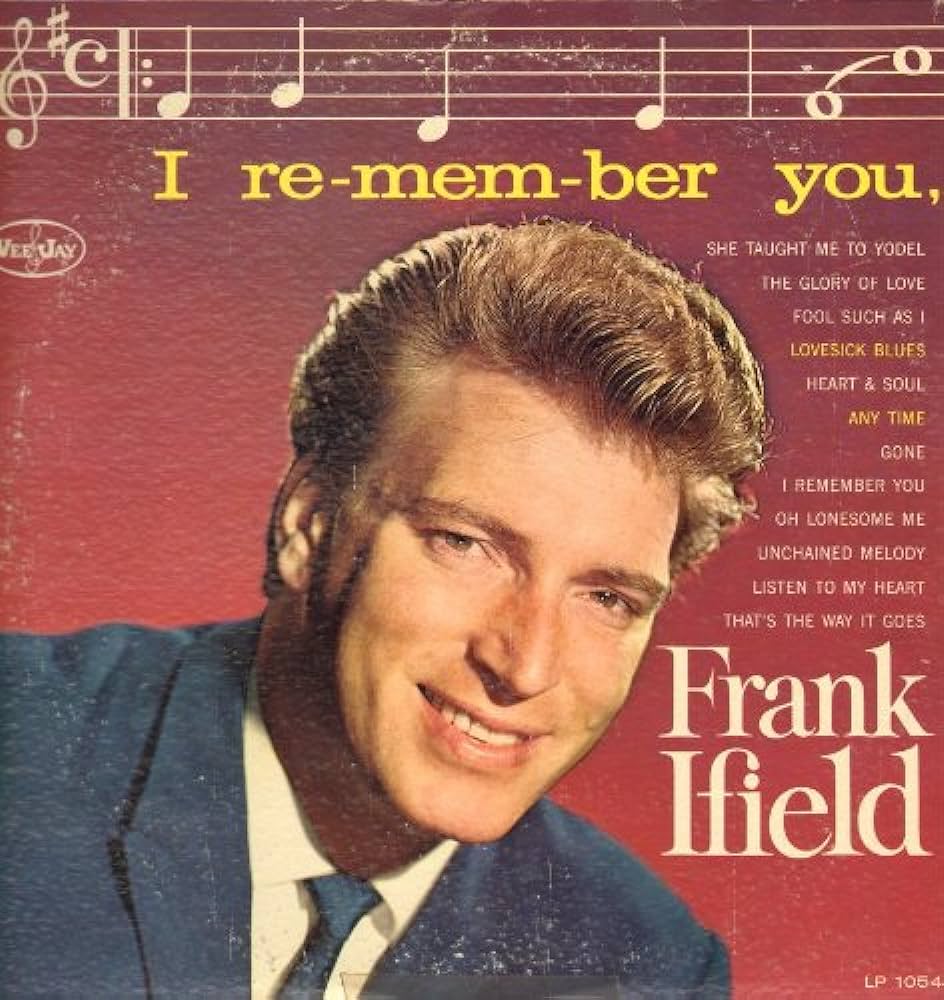 In 1962, Vee-Jay records were offered a chance to release a #1 British single in America by Frank Ifield called “I Remember You,” which Vee-Jay took to the Top Five on the US Billboard Hot 100. As part of the deal, they also accepted a five year contract with an unknown new British band called The Beatles, even though the band had yet to have a proper recording session at that time. In 1962, Vee-Jay records were offered a chance to release a #1 British single in America by Frank Ifield called “I Remember You,” which Vee-Jay took to the Top Five on the US Billboard Hot 100. As part of the deal, they also accepted a five year contract with an unknown new British band called The Beatles, even though the band had yet to have a proper recording session at that time.
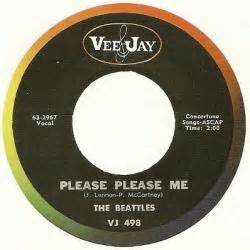 Vee-Jay released the very first Beatles single in the US, this being “Please Please Me / Ask Me Why”, on February 7th, 1963 (misspelling the artist as Beattles), which got very little attention and did not place at all on the US Billboard charts. Vee-Jay then released a second single on May 27th, 1963, “From Me To You / Thank You Girl” which did get some attention in certain US markets, but peaked only at #116 on the Billboard pop chart. Vee-Jay released the very first Beatles single in the US, this being “Please Please Me / Ask Me Why”, on February 7th, 1963 (misspelling the artist as Beattles), which got very little attention and did not place at all on the US Billboard charts. Vee-Jay then released a second single on May 27th, 1963, “From Me To You / Thank You Girl” which did get some attention in certain US markets, but peaked only at #116 on the Billboard pop chart.
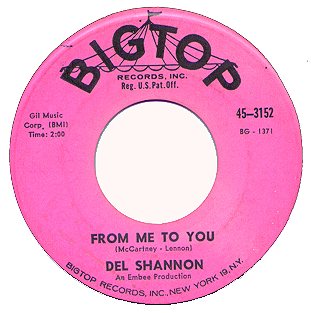 Part of the problem, it is claimed by many, was that Del Shannon had released a cover version of “From Me To You” which was competing with The Beatles original version on the charts. Since Del Shannon’s version only reached #77 on the Billboard Hot 100 in June of 1963, it is evident that the timing was just not right for The Beatles to make an impact in the United States. Part of the problem, it is claimed by many, was that Del Shannon had released a cover version of “From Me To You” which was competing with The Beatles original version on the charts. Since Del Shannon’s version only reached #77 on the Billboard Hot 100 in June of 1963, it is evident that the timing was just not right for The Beatles to make an impact in the United States.
Origin of the Album
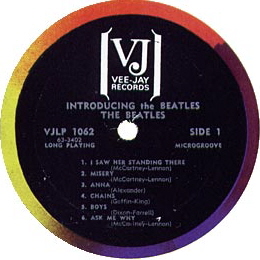 Since Vee-Jay Records had the US contract for releasing The Beatles' records at the time (EMIs American affiliate Capitol Records having passed at their opportunity), this Chicago R&B label had prepared to release the first Beatles album in July of 1963, which they titled, “Introducing…THE BEATLES, Englands No. 1 Vocal Group.” The mother plates for stamping the album had been constructed by July 22nd, 1963. This is why some conclude that the album was first released in July 1963, since this date can be seen in the run-off area of many of the original albums. Distribution of the album didn’t happen at all until months later because of a “shake-up” at Vee-Jay headquarters. Since Vee-Jay Records had the US contract for releasing The Beatles' records at the time (EMIs American affiliate Capitol Records having passed at their opportunity), this Chicago R&B label had prepared to release the first Beatles album in July of 1963, which they titled, “Introducing…THE BEATLES, Englands No. 1 Vocal Group.” The mother plates for stamping the album had been constructed by July 22nd, 1963. This is why some conclude that the album was first released in July 1963, since this date can be seen in the run-off area of many of the original albums. Distribution of the album didn’t happen at all until months later because of a “shake-up” at Vee-Jay headquarters.
Vee-Jay Management Problems
 On August 3rd, 1963, it was released in the press that Vee-Jay’s president, Ewart Abner, Jr, as well as others in executive positions, had exited the firm. Also, significantly, The Four Seasons had filed a lawsuit against Vee-Jay for nonpayment of royalties. This had also been the case with The Beatles' US royalties, as insignificant as they were at the time. However, The Four Seasons were their top money maker, so Vee-Jay had no choice but to lessen expenses somehow, which resulted in halting the release of many of the proposed albums on their future roster, including “Introducing…The Beatles.” On August 3rd, 1963, it was released in the press that Vee-Jay’s president, Ewart Abner, Jr, as well as others in executive positions, had exited the firm. Also, significantly, The Four Seasons had filed a lawsuit against Vee-Jay for nonpayment of royalties. This had also been the case with The Beatles' US royalties, as insignificant as they were at the time. However, The Four Seasons were their top money maker, so Vee-Jay had no choice but to lessen expenses somehow, which resulted in halting the release of many of the proposed albums on their future roster, including “Introducing…The Beatles.”
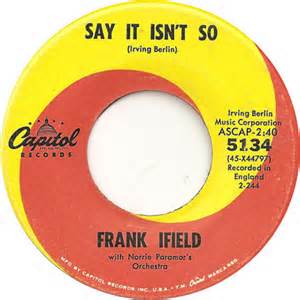 A gray area then presented itself concerning Vee-Jay’s contract to release The Beatles records in the US. EMI asked Vee-Jay to release them from the contract they signed for Frank Ifield, which they did. The future releases for Frank Ifield were now on Capitol records. It was then assumed by EMI that this negotiation would also release The Beatles from their five year contract with Vee-Jay Records. However, Vee-Jay claimed that this was not the case, and that they still had the rights to release any Beatles product they had in their possession as they saw fit to do in the future. A gray area then presented itself concerning Vee-Jay’s contract to release The Beatles records in the US. EMI asked Vee-Jay to release them from the contract they signed for Frank Ifield, which they did. The future releases for Frank Ifield were now on Capitol records. It was then assumed by EMI that this negotiation would also release The Beatles from their five year contract with Vee-Jay Records. However, Vee-Jay claimed that this was not the case, and that they still had the rights to release any Beatles product they had in their possession as they saw fit to do in the future.
Enter Capitol Records
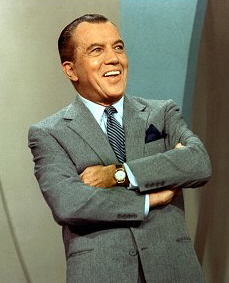 Capitol Records then entered into the Beatles picture. The label negotiated a contract with Brian Epstein, The Beatles' manager, to secure the rights for any and all Beatles product, past and future. Capitol's people agreed to a $40,000 campaign to promote their first Capitol single and subsequent album. Ed Sullivan had already agreed by this time to have The Beatles appear on his show in February 1964. Television news and magazines had been running features on "Beatlemania" as it was happening in England in late 1963. Capitol Records then entered into the Beatles picture. The label negotiated a contract with Brian Epstein, The Beatles' manager, to secure the rights for any and all Beatles product, past and future. Capitol's people agreed to a $40,000 campaign to promote their first Capitol single and subsequent album. Ed Sullivan had already agreed by this time to have The Beatles appear on his show in February 1964. Television news and magazines had been running features on "Beatlemania" as it was happening in England in late 1963.
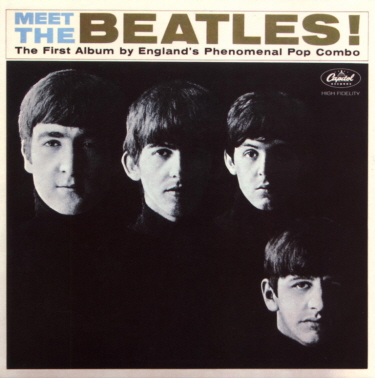 This opportunity was way too tempting for Vee-Jay Records to pass up. Even though they knew that a definite “gray area” existed regarding their original five year contract with The Beatles, they were in bad enough financial straits to hold their breath and finally release the “Introducing…The Beatles” album, as well as re-releasing the single “Please Please Me” (this time backed with “From Me To You”). The album was rush-released on January 10th, 1964, becoming the first Beatles album ever released in America. They beat Capitol Records to the punch by releasing their album ten days before the first "official" Capitol Beatles album “Meet The Beatles!” was released. This opportunity was way too tempting for Vee-Jay Records to pass up. Even though they knew that a definite “gray area” existed regarding their original five year contract with The Beatles, they were in bad enough financial straits to hold their breath and finally release the “Introducing…The Beatles” album, as well as re-releasing the single “Please Please Me” (this time backed with “From Me To You”). The album was rush-released on January 10th, 1964, becoming the first Beatles album ever released in America. They beat Capitol Records to the punch by releasing their album ten days before the first "official" Capitol Beatles album “Meet The Beatles!” was released.
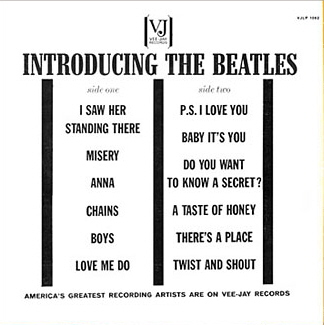 This event did not go unnoticed by Capitol. The label filed suit against Vee-Jay with an injunction against manufacturing, distributing, advertising, or otherwise disposing of Beatles' records. This legal fiasco continued for months with multiple suits and countersuits being filed. An early court ruling disfavored Vee-Jay Records because of the inclusion of the songs “Love Me Do” and “PS I Love You” on their Beatles' album since these songs were published through Beechwood Music, a subsidiary of Capitol Records. Vee-Jay acted quickly by re-pressing the album without those two songs, replacing them with “Ask Me Why” and “Please Please Me.” This new version of the album was released around February 10th, 1964. This event did not go unnoticed by Capitol. The label filed suit against Vee-Jay with an injunction against manufacturing, distributing, advertising, or otherwise disposing of Beatles' records. This legal fiasco continued for months with multiple suits and countersuits being filed. An early court ruling disfavored Vee-Jay Records because of the inclusion of the songs “Love Me Do” and “PS I Love You” on their Beatles' album since these songs were published through Beechwood Music, a subsidiary of Capitol Records. Vee-Jay acted quickly by re-pressing the album without those two songs, replacing them with “Ask Me Why” and “Please Please Me.” This new version of the album was released around February 10th, 1964.
Success of “Introducing…The Beatles”
 The album ended up selling well over a million copies, this being evidenced by Vee-Jay Records presenting The Beatles with a gold record for “Introducing…The Beatles” album backstage at their Hollywood Bowl show in Los Angeles on October 23rd, 1964. The album spent nine straight weeks at the #2 position on the US Billboard album chart, not quite managing to beat out Capitol’s “Meet The Beatles!” to the #1 spot. The album ended up selling well over a million copies, this being evidenced by Vee-Jay Records presenting The Beatles with a gold record for “Introducing…The Beatles” album backstage at their Hollywood Bowl show in Los Angeles on October 23rd, 1964. The album spent nine straight weeks at the #2 position on the US Billboard album chart, not quite managing to beat out Capitol’s “Meet The Beatles!” to the #1 spot.
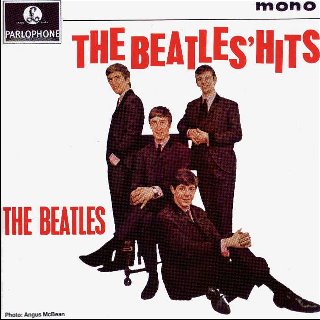 It was a shame that the first Beatles album to appear in the US was rush-released in an unflattering record sleeve. The front cover photograph was actually a reversed image of the original photograph (as can be seen on the British EP “The Beatles’ Hits”), which is why the parting of their hair and the balance of their facial features look somewhat odd. It was a shame that the first Beatles album to appear in the US was rush-released in an unflattering record sleeve. The front cover photograph was actually a reversed image of the original photograph (as can be seen on the British EP “The Beatles’ Hits”), which is why the parting of their hair and the balance of their facial features look somewhat odd.
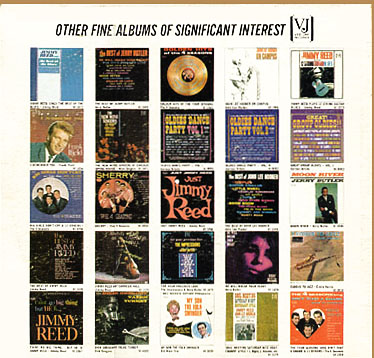 Typically, the back cover of '60s American album sleeves had pictures of the artists as well as liner notes encouraging record buyers' interest and informing potential listeners of the quality of the music contained therein. In this case, because of the rush-release, the back of the sleeve contained only a list of the song titles, underscored by the statement, “America’s greatest recording artists are on Vee-Jay Records.” In fact, the first record sleeves pressed didn’t even have that. The first back cover had advertisements for other albums released on Vee-Jay records, such as Jimmy Reed and The Four Seasons. When copies of these ran out, blank sleeves were placed on the back of the album jacket until the sleeves with the song list could be prepared. Because of the immense hype generated through the Capitol records ad campaign, Vee-Jay felt this album would sell even without informing the customers what songs were contained on it. And they were right! Typically, the back cover of '60s American album sleeves had pictures of the artists as well as liner notes encouraging record buyers' interest and informing potential listeners of the quality of the music contained therein. In this case, because of the rush-release, the back of the sleeve contained only a list of the song titles, underscored by the statement, “America’s greatest recording artists are on Vee-Jay Records.” In fact, the first record sleeves pressed didn’t even have that. The first back cover had advertisements for other albums released on Vee-Jay records, such as Jimmy Reed and The Four Seasons. When copies of these ran out, blank sleeves were placed on the back of the album jacket until the sleeves with the song list could be prepared. Because of the immense hype generated through the Capitol records ad campaign, Vee-Jay felt this album would sell even without informing the customers what songs were contained on it. And they were right!
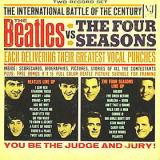 Vee-Jay had to eventually relinquish its rights to the early Beatles' catalog by October 15th 1964. Before that time arrived, they released as many singles, EPs and albums as they saw fit in order to cash in on the Beatle craze while they could. They even re-released the “Introducing…The Beatles” album in two more forms. “The Beatles vs. The Four Seasons” (VJDX 30) was the first, this being released on October 1st, 1964. This came out as a double album consisting of the Beatles disc along with “'The Golden Hits of The Four Seasons.” Being a higher priced double album, this compilation set only peaked at #142 on the Billboard album chart, selling only 20,000 copies. Vee-Jay had to eventually relinquish its rights to the early Beatles' catalog by October 15th 1964. Before that time arrived, they released as many singles, EPs and albums as they saw fit in order to cash in on the Beatle craze while they could. They even re-released the “Introducing…The Beatles” album in two more forms. “The Beatles vs. The Four Seasons” (VJDX 30) was the first, this being released on October 1st, 1964. This came out as a double album consisting of the Beatles disc along with “'The Golden Hits of The Four Seasons.” Being a higher priced double album, this compilation set only peaked at #142 on the Billboard album chart, selling only 20,000 copies.
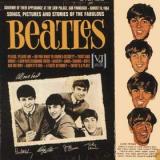 The second form was the album “Songs, Pictures And Stories Of The Fabulous Beatles” (VJLP 1092) on October 12th, 1964. It was the actual original “Introducing” album placed in a new sleeve. It managed to fool some Beatle fans, as it peaked at #63 on the Billboard album chart, selling 400,000 copies. The second form was the album “Songs, Pictures And Stories Of The Fabulous Beatles” (VJLP 1092) on October 12th, 1964. It was the actual original “Introducing” album placed in a new sleeve. It managed to fool some Beatle fans, as it peaked at #63 on the Billboard album chart, selling 400,000 copies.
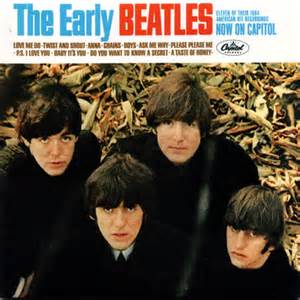 Capitol records decided to focus on the early Beatles catalog on March 22nd, 1965 with their album release “The Early Beatles.” As this album only peaked at #43 on the Billboard album chart, Beatles fans were showing themselves not willing to buy the same group of songs they had already purchased many times over. Being that Vee-Jay records finally went out of business in May of 1966, and “Introducing…The Beatles” had been officially out of print since October 1964, Capitol records had the rights to official release of the early Beatles catalog, and would continue to for the indefinite future. Capitol records decided to focus on the early Beatles catalog on March 22nd, 1965 with their album release “The Early Beatles.” As this album only peaked at #43 on the Billboard album chart, Beatles fans were showing themselves not willing to buy the same group of songs they had already purchased many times over. Being that Vee-Jay records finally went out of business in May of 1966, and “Introducing…The Beatles” had been officially out of print since October 1964, Capitol records had the rights to official release of the early Beatles catalog, and would continue to for the indefinite future.
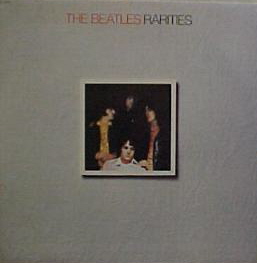 It is of some interest to note that Capitol Records failed to release two songs from the “Introducing” album on any Beatles’ album during their career, even when they were in dire need of songs to release on their makeshift US albums. “Misery” and “There’s A Place,” two Lennon / McCartney originals, were not released by Capitol on any album until March 24th, 1980 on the compilation album “Rarities.” Until this date, most Beatles fans considered these two songs “lost” Beatles tracks, as they were not available on any album in the US until then. It is of some interest to note that Capitol Records failed to release two songs from the “Introducing” album on any Beatles’ album during their career, even when they were in dire need of songs to release on their makeshift US albums. “Misery” and “There’s A Place,” two Lennon / McCartney originals, were not released by Capitol on any album until March 24th, 1980 on the compilation album “Rarities.” Until this date, most Beatles fans considered these two songs “lost” Beatles tracks, as they were not available on any album in the US until then.
Recording The Album
The Beatles recording this entire album in EMI Studio Two in just over 12 hours (excluding the previous single releases) seems like an enormous feat considering the weeks, months and even years recording an album can take today. Although it has been admitted by The Beatles that it was hard work, it wasn’t something that they weren’t used to.
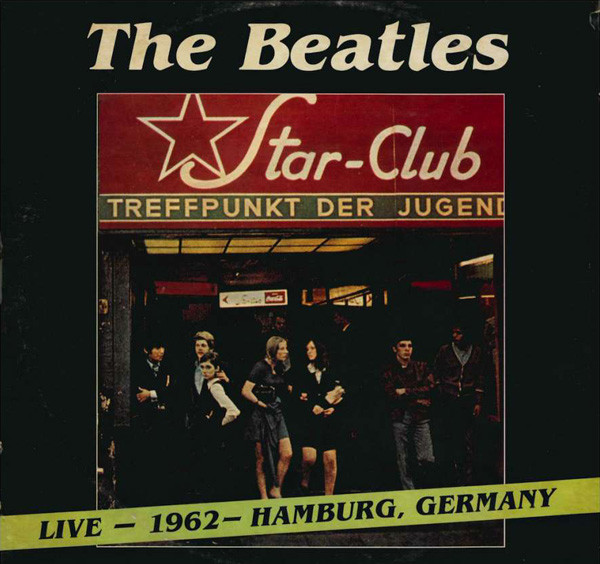 Paul stressed in a 1988 interview that, since they were used to the rigors of playing in Hamburg, Germany, having a 12 and a half hour recording session was “no big deal.” They were used to playing sometimes from 7pm until 3am, six nights a week. Since mid-1960, they had been performing live non-stop on virtually a daily basis. In actuality, the day this album was recorded was an off day from their first headlining national tour. They weren’t exactly in the peak of physical condition, having worked throughout the country during one of the coldest British winters on record. The album had to be completed on this day because of two scheduled performances they had the next evening. Paul stressed in a 1988 interview that, since they were used to the rigors of playing in Hamburg, Germany, having a 12 and a half hour recording session was “no big deal.” They were used to playing sometimes from 7pm until 3am, six nights a week. Since mid-1960, they had been performing live non-stop on virtually a daily basis. In actuality, the day this album was recorded was an off day from their first headlining national tour. They weren’t exactly in the peak of physical condition, having worked throughout the country during one of the coldest British winters on record. The album had to be completed on this day because of two scheduled performances they had the next evening.
 The plethora of books written outlining The Beatles' 1960-1962 performance experiences can only leave fans wondering longingly at what they might have sounded like way back then. John Lennon, in an interview in 1976, described this album as the closest thing you can get to experiencing how The Beatles sounded live in Hamburg and Liverpool, less the audience of course. The plethora of books written outlining The Beatles' 1960-1962 performance experiences can only leave fans wondering longingly at what they might have sounded like way back then. John Lennon, in an interview in 1976, described this album as the closest thing you can get to experiencing how The Beatles sounded live in Hamburg and Liverpool, less the audience of course.
This website has been designed to give the most thorough detail, track by track, of each album as it was heard in the US. Analysis of this album, along with the details included herein, will give as accurate a picture as possible of what the pre-fame Beatles sounded like without actually having been there.
Written and compiled by Dave Rybaczewski
CLICK ON THE SONG TITLES BELOW TO READ THE IN-DEPTH HISTORY OF THE SONGS ON "INTRODUCING THE BEATLES"
|
IF YOU WOULD LIKE TO MAKE A DONATION TO KEEP THIS WEBSITE UP AND RUNNING, PLEASE CLICK BELOW!
Sign Up Below for our MONTHLY BEATLES TRIVIA QUIZ!
|